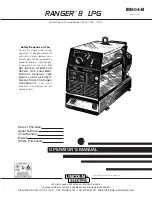
Page 45
8.00
HANDRAILS
8.10
Faulty
Operation
9.00
Lift-Tite
™
Latches
9.10
Faulty
Operation
Troubleshooting Diagnosis Chart
FUNCTION
SYMPTOM
POSSIBLE CAUSE
REMEDY
6.00
PLATFORM
FOLD
(In)
6.10
No
Operation
6.30
Faulty or
Sluggish
Operation
6.11 Platform not fully raised
6.12 See 1.00 and 5.25
6.13 Up/Fold Microswitch defective or out
of adjustment
6.14 Platform Hydraulic Pressure Sensor
Switch out of adjustment or
defective
6.15 Microswitch or hydraulic pressure
switch harness(s) disconnected,
damaged or otherwise defective
6.21 See 5.20
6.31 See 2.21, 2.22, 2.23, 2.24, 2.25,
2.26, 2.27, 2.28, 2.29, 6.13 and
6.14
6.41 See 5.40
6.42 Lift-Tite™ latches not securing
platform mounted catch rollers.
7.11 See 5.11, 5.22, 5.24 and 5.41
7.12 Lost prime
7.13 Air leak at backup pump to pump
interface (O-rings)
7.21 See 3.20
7.22 Lift platform has drifted against
Lift-Tite™ latches
8.11 Slide support arm guide bolts
improperly adjusted (tightness),
missing or damaged
8.12 Worn bushings/pivot pins
8.13 Pivot pins misaligned (hardware
missing) or otherwise damaged
8.14 Handrail bent, deformed or
otherwise damaged
9.11 See 6.42
Raise platform
Adjust or replace.
See Microswitches in
Systems Descriptions for details (page
37)
Adjust or replace.
See Platform Hydraulic
Pressure Sensor Switch in Systems
Descriptions for details (page 39)
Connect, repair or replace
Verify mounting hardware is in place and
dampening springs retract after being
extended. Platform catch roller retainers
must be secure and rollers spin freely.
Lubricate and/or replace.
Prime.
See Systems Descriptions for
Priming and Flushing procedure
Check tightness or leaks
Pump lift platform fully up then release
Correct or replace
Replace
Correct or replace
Correct or replace
6.20
Motor Runs
But
Doesn’t Fold
6.40
Platform
Drifts
Down (Out)
7.10
Up
(Faulty Operation)
7.20
Down
(Faulty Operation)
7.00
MANUAL
BACK-UP
PUMP
















































